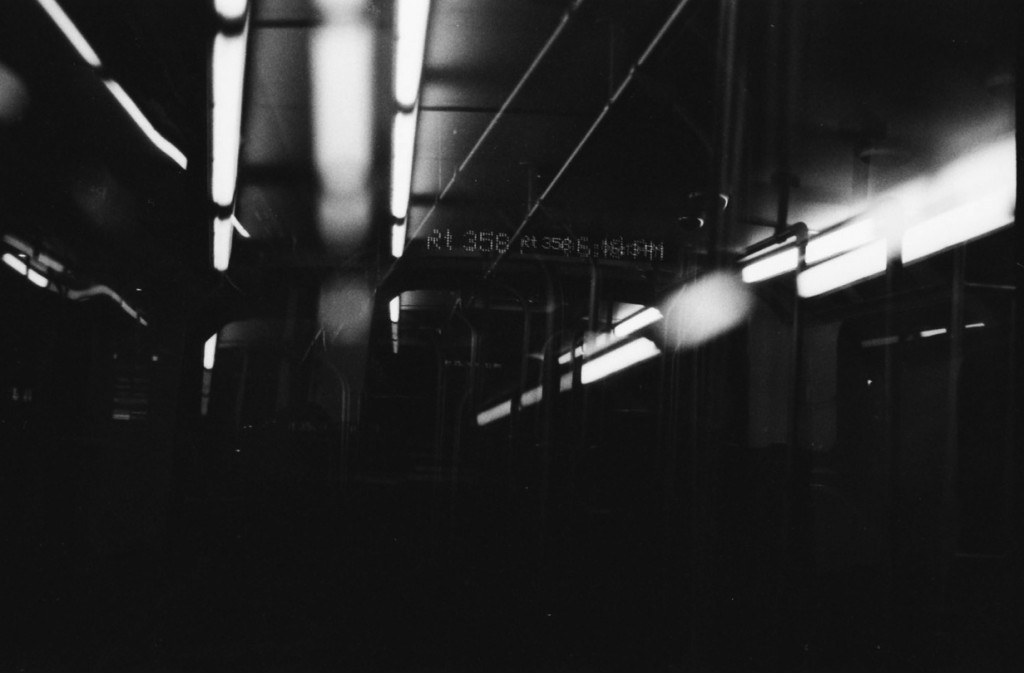
I’m riding home from Sea-Tac with a dear friend of mine. The last train headed for downtown has already left for the night, and we thus opt for a late-night 124 to work our way back into town. For decades Metro offered 24-hour service from downtown to Sea-Tac; maybe someday when there’s money they’ll consider doing so again. But nevermind. My friend and I pass the time pleasantly at Tukwila International Boulevard Station–yes, such a thing is possible at 1:30am! She and I talk around in detailed circles, always with more to say to each other, sharing space with the working few.
For tonight at least, the hour has since passed for drunks and users. Now is the quiet time, that elusive pre-dawn realm populated by people who very much need the bus. Cruising down the Boulevard now, I look around at the nations seated beside me, hollow cheeks and thoughtful, tired eyes, gazing into the middle distance, statuesque and contemplative, resting on the go.
Mostly men here, but not all, dressed in layered practicality: raincoats, work coats, sweaters, hoodies, windbreakers, reflective jackets… all with a tinge of earthy scrappiness. We’re on Pac Highway after all, and this is no place for the careless. The globe, our globe, balances precariously on the services and elemental labor these folks provide, and would swiftly crumble if not for their continued presence.
The 124 driver, also a friend of mine, takes us gently through the night like the seasoned pro that she is. One of my favorite things about being an operator- and something I never anticipated- is the sense of being surrounded by people you know whenever you’re going about the city on foot or by bus. Those are all your friends or acquaintances out there, familiar working faces on the move.
Seated- sprawled is a better word- about the front seat is a thin African-American man of roughly thirty. Oversized dark gray sweater with the collar turned up, black jeans and fuzzy cornrows ending in a bun behind his head. He stares vacantly, head resting on the top of the seat, his body draped in an expansive slouch, conforming to the surfaces around him.
At some point an older woman boards. She steps in slowly, heavier, hobbling forward on swollen limbs, colorful knee-high socks mostly covering her pale and puckered skin. She’s white and sixty-plus, with friendly eyes and her hands full- a bag, a backpack, a cane.
Cornrows notes her presence entering and, without waiting for any suggestion, gets up to offer his seat to her. He’s already stepping away when she manages a “thank you.”
“Oh, that’s no problem at all,” he says. He says it fluidly and quietly, a natural kindness, in a cadence I wouldn’t have expected based on his dress and stance. Had my eyes been closed I’d have thought he was Cary Grant. Sometimes the 124 is more than worthy of the “Jerry Springer” designation; tonight we’ve got Jimmy Stewart in here. We’ve got Sydney Poitier.
Nathan Vass is an artist, filmmaker, photographer, and author by day, and a Metro bus driver by night, where his community-building work has been showcased on TED, NPR, The Seattle Times, KING 5 and landed him a spot on Seattle Magazine’s 2018 list of the 35 Most Influential People in Seattle. He has shown in over forty photography shows is also the director of nine films, six of which have shown at festivals, and one of which premiered at Henry Art Gallery. His book, The Lines That Make Us, is a Seattle bestseller and 2019 WA State Book Awards finalist.



